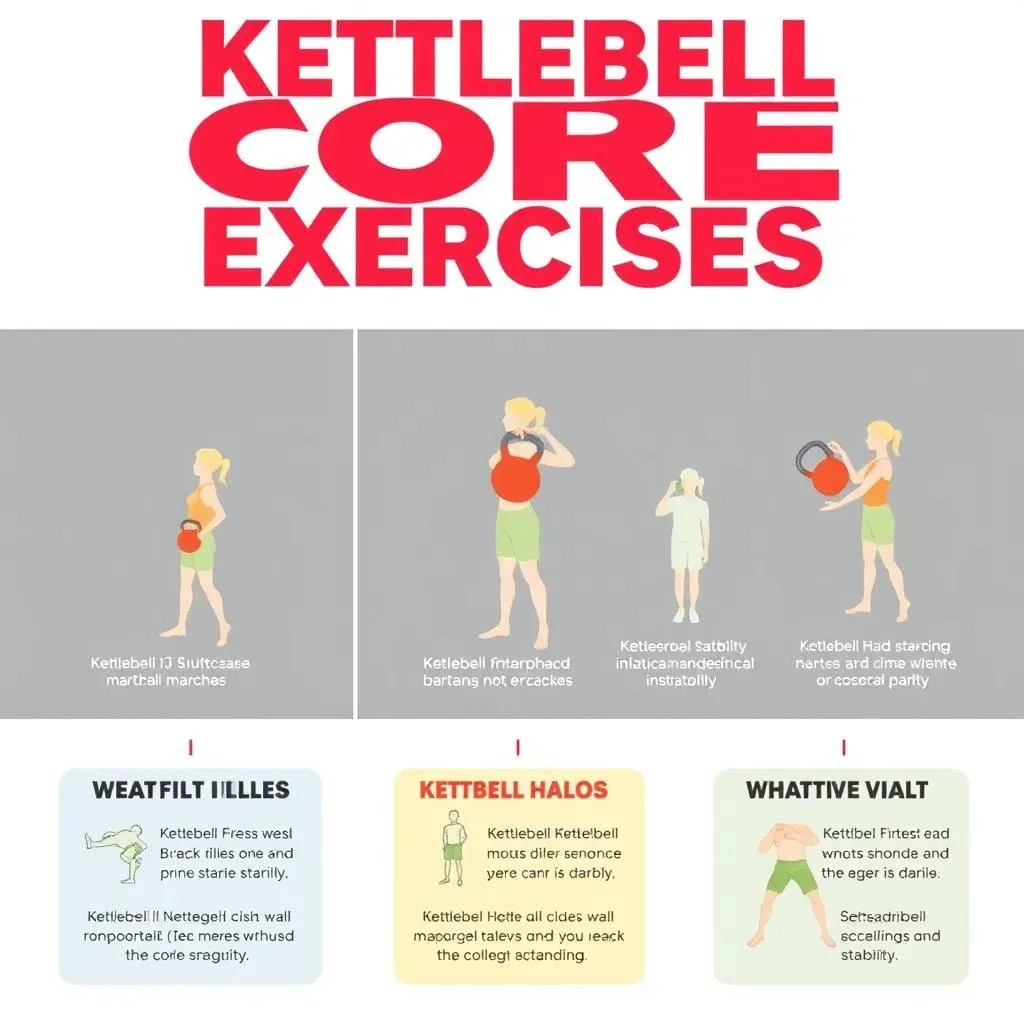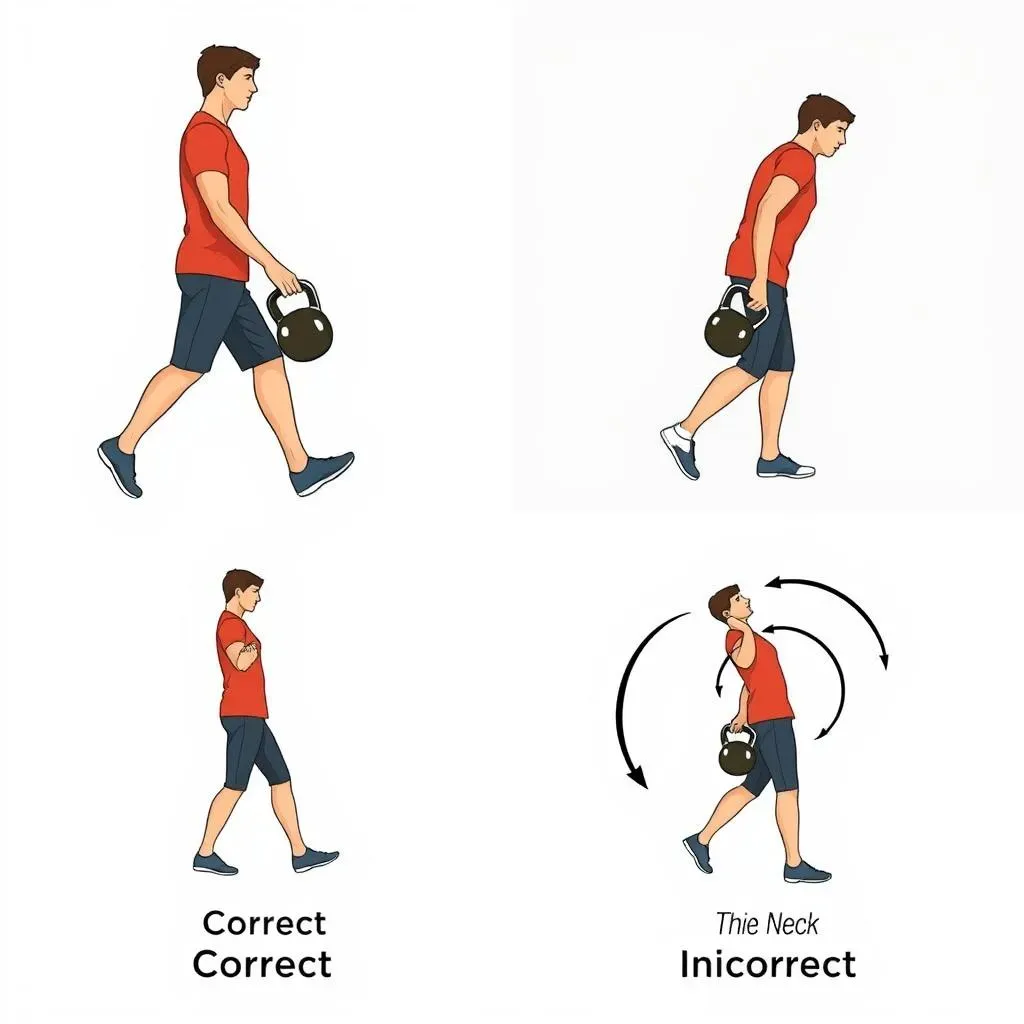Table of Contents
Tired of endless crunches that leave your neck aching? What if I told you there's a better way to carve out a strong core? Forget lying on the floor; it's time to stand up and get to work with kettlebells. This article isn't about those old-school ab exercises you dread. We're diving into the world of standing kettlebell core exercises. These aren't just any moves; they're a dynamic, full-body approach to core training that will challenge you in new ways. We'll explore why these exercises are so effective, then I'll walk you through five key movements that will transform your midsection. You'll learn the proper technique for each exercise, and finally, I'll show you how to put it all together into a workout that fits your schedule. Get ready to feel the burn and see real results with standing kettlebell core exercises.
Why Standing Kettlebell Core Exercises are a Game Changer

Why Standing Kettlebell Core Exercises are a Game Changer
Beyond the Crunch
let's be real: crunches are boring. They also don't do much for your core beyond a tiny bit of ab muscle activation. Standing kettlebell core exercises, on the other hand, light up your entire midsection, your obliques, lower back, and even your glutes and shoulders get in on the action. It's like a full-body party, and your core is the guest of honor. This is because when you're standing, your body has to work harder to stabilize itself. Think about it: you're not just isolating a muscle, you're challenging your balance, coordination, and overall strength.
I remember the first time I tried a kettlebell windmill. I thought, "This looks easy." Boy, was I wrong! I felt muscles I didn't even know I had working overtime. It was a wake-up call. I realized that traditional core exercises were just scratching the surface. Standing kettlebell moves are like the difference between a tiny sparkler and a full-blown fireworks show for your core. They're not only more effective, they're also way more engaging.
Functional Strength in Action
Another reason why I'm so hooked on standing kettlebell core exercises is how functional they are. We don't live our lives lying on our backs, right? We're constantly moving, twisting, reaching, and bending. These exercises mimic those real-life movements, building a core that is not just strong, but also resilient and ready for anything. Think about carrying groceries, playing with your kids, or even just getting out of bed. A strong, stable core makes all of these daily activities easier and safer. These aren't just for gym rats; they're for anyone who wants to move better and feel better in their body.
Plus, they're a great way to sneak in some extra cardio. I've found myself sweating more during a set of kettlebell hand-to-hand passes than I ever did doing endless sets of sit-ups. It's a win-win: you're building a powerhouse core while getting your heart rate up. It’s about building a core that does more than just look good; it helps you thrive in your everyday life.
Benefit | Standing Kettlebell Core | Traditional Core Exercises |
|---|---|---|
Muscle Activation | Full core engagement, plus other muscle groups | Limited to primarily abdominal muscles |
Functionality | Mimics real-life movements | Limited carryover to daily activities |
Engagement | Dynamic and challenging | Can be repetitive and boring |
Calorie Burn | Higher due to full-body involvement | Lower |
The 5 MustDo Standing Kettlebell Core Exercises

The 5 MustDo Standing Kettlebell Core Exercises
Kettlebell Suitcase Marches
let's kick things off with the kettlebell suitcase march. It might sound like you're just walking around with a weight, but trust me, there's more to it. Hold a kettlebell in one hand, like you're carrying a suitcase, and walk slowly, focusing on keeping your core tight and your body upright. You'll feel your obliques working hard to prevent you from leaning to one side. It’s a simple move, but it’s a sneaky way to build core stability and improve your posture. Think of it as a marching band for your core, keeping everything in line and strong. I use this one as a warm up to get my core fired up.
Don't just swing the kettlebell around. Keep your movements controlled and intentional. The goal here isn't to walk fast, but to walk strong. It's about that constant tension and the awareness of your core as you move. You'll be surprised how much this simple march can challenge you when you do it right.
Kettlebell Halos
Next up, we have kettlebell halos. This one looks a bit like you’re trying to put a halo on your head, but with a kettlebell. Hold the kettlebell by the horns (the sides of the handle), and slowly circle it around your head, keeping your core engaged and your back straight. This exercise is fantastic for improving shoulder mobility and core stability at the same time. I like to use this one to warm up my upper back and core before a heavy workout. It’s like giving your body a nice, gentle hug while strengthening your core.
The key here is to keep the motion smooth and controlled. Don't rush it, and don’t let the kettlebell pull you off balance. Imagine you're tracing a perfect circle with the kettlebell, and keep your movements precise. This isn't a race; it's about feeling those muscles work. You’ll find that this exercise not only strengthens your core, but it also loosens up your shoulders and upper back, making it a great all-rounder.
Exercise | Primary Focus | Secondary Benefits |
|---|---|---|
Kettlebell Suitcase Marches | Oblique Strength and Stability | Posture and Balance |
Kettlebell Halos | Core Stability and Shoulder Mobility | Upper Back Flexibility |
Kettlebell Windmills
Now, let's talk about kettlebell windmills. This is where things get a bit more challenging, but it's also where you'll see some serious core strength gains. Stand with your feet shoulder-width apart, holding a kettlebell in one hand overhead. Then, hinge at your hips, reaching your free hand towards the ground while keeping the kettlebell arm straight. This move is a masterclass in core stability and hip mobility. It’s like a dance between your core and your hips, and you're the choreographer. This is one of the exercises that made me realize how important core stability is for overall strength.
The secret to a good kettlebell windmill is to keep your core engaged throughout the entire movement. Don't let your back round, and don't rush the motion. Focus on the feeling of your core working to stabilize your body as you hinge at your hips. It's a challenging move, but it’s incredibly rewarding when you nail it. It targets the obliques and the lower back, building a strong foundation for all your other lifts.
How to Execute Each Standing Kettlebell Core Exercise Perfectly

How to Execute Each Standing Kettlebell Core Exercise Perfectly
Mastering the Basics
so you've got the exercises down, but let's talk about making sure you're doing them right. It's not just about moving the kettlebell around; it’s about moving it with intention and control. For the suitcase march, think about keeping your shoulders level and your core braced, like you're about to take a punch in the gut. Don’t let that kettlebell pull you to one side. Your body should stay as straight as possible, with only your legs moving. With kettlebell halos, it's all about smooth, even circles around your head. Don't let the kettlebell swing wildly, and try to keep your neck relaxed. Imagine you’re drawing a perfect circle in the air, and let your core guide the movement. It's not about speed; it's about precision and control.
I know it can be tempting to rush through things, especially when you're just starting out. But trust me, slowing down and focusing on your form will pay off big time. It's like building a house. You wouldn't skip the foundation, right? The same goes for your core. Mastering the basic form of these exercises will not only make them more effective, but also prevent injuries. I’ve seen so many people get hurt trying to do too much too soon. So, take your time, focus on the details, and build that strong foundation first.
Fine-Tuning Your Form
When it comes to kettlebell windmills, the key is to hinge at your hips, not your back. Imagine you're trying to touch a wall behind you with your butt, and let your body follow that motion. Keep your core engaged throughout, and don't let your back round. Your non-kettlebell hand should reach down towards the ground, but don't force it. Go as far as you can while maintaining that straight back and stable core. As for kettlebell hand-to-hand passes, think about keeping your core tight and your movements controlled. Don't just throw the kettlebell around; pass it smoothly from one hand to the other, and keep your body as still as possible. And finally, with kettlebell openers, it's all about that twist in your torso. Keep your feet planted, and let your core do the work. Don't let your arms take over; the movement should come from your obliques.
It's like you're winding up a spring in your core, and then letting it unwind with each rep. Remember, it’s okay if you don’t get it perfect right away. Even I had to practice these moves a ton of times before I felt comfortable with them. The important thing is to be patient with yourself, pay attention to your body, and keep practicing. It's like learning a new dance; it might feel awkward at first, but with time and practice, it becomes second nature.
Exercise | Key Technique Points | Common Mistakes |
|---|---|---|
Kettlebell Suitcase Marches | Keep shoulders level, core braced, walk slowly | Leaning to one side, swinging the kettlebell |
Kettlebell Halos | Smooth, even circles, relaxed neck, core engaged | Swinging wildly, tensing the neck |
Kettlebell Windmills | Hinge at hips, straight back, core engaged | Rounding the back, rushing the motion |
Kettlebell Hand-to-Hand Passes | Controlled passes, tight core, still body | Throwing the kettlebell, moving the body too much |
Kettlebell Openers | Twist at the torso, core does the work, feet planted | Letting arms take over, moving the feet |
Crafting Your Standing Kettlebell Core Workout

Crafting Your Standing Kettlebell Core Workout
Building Your Base
Alright, so you've got the moves down, now let's talk about putting them together into a workout. Don't just jump in and start throwing kettlebells around like a maniac. Start slow, focus on proper form, and gradually increase the intensity as you get stronger. I like to start with a warm-up, something simple like some light cardio and dynamic stretches. Think arm circles, leg swings, and some torso twists. It's all about getting your body ready to work. Then, I like to choose 2-3 of the standing kettlebell exercises we've talked about, and do 3 sets of 8-12 reps for each one. Take about 60-90 seconds of rest between sets. It’s not about rushing; it’s about quality over quantity.
Remember, consistency is key. It's better to do a short, effective workout a few times a week than to try to kill yourself with a marathon session once a month. I find that 20-30 minutes is plenty to get a good workout in. And don't be afraid to mix things up. Some days I might focus on kettlebell windmills and suitcase marches, other days I might do halos and hand-to-hand passes. The most important thing is to listen to your body and do what feels right for you. If something hurts, stop. It’s not a competition; it’s about building a stronger, more resilient body.
Sample Workout Format
To give you a better idea, here's a sample workout format that I use: Start with 5 minutes of light cardio and dynamic stretching. Then, choose three of the standing kettlebell core exercises we discussed earlier. You can do this as a circuit, performing each exercise for 8-12 reps, then resting for about a minute before repeating the circuit two more times. Or, you can do all three sets for each exercise before moving on to the next one. For example, you could do 3 sets of 10 reps of kettlebell windmills, followed by 3 sets of 10 reps of kettlebell suitcase marches, and then 3 sets of 10 reps of kettlebell halos. It is all about finding what works for you.
I also like to use an every-minute-on-the-minute (EMOM) approach. It's a great way to keep you accountable, and it adds a bit of a challenge to the workout. Set a timer for 10 minutes. At the start of each minute, perform a set of 8-10 reps of a standing kettlebell exercise. The rest of the minute is your rest. When the next minute starts, you start the next set. I usually do this for 3 different exercises, so I'm doing 3 sets of each in a 10-minute period. It's a fun way to challenge yourself, and it keeps the workout fresh.
Workout Component | Description | Duration |
|---|---|---|
Warm-up | Light cardio and dynamic stretching | 5 minutes |
Kettlebell Exercises | 2-3 standing kettlebell moves | 3 sets of 8-12 reps per exercise |
Rest | Between sets | 60-90 seconds |
Cool-down | Static stretching | 5 minutes |
Progression and Listening to Your Body
As you get stronger, you'll want to increase the intensity of your workouts. This could mean increasing the weight of the kettlebell, increasing the number of reps or sets, or decreasing the rest time between sets. Don’t be afraid to challenge yourself, but always listen to your body. If you're feeling pain, stop. It's always better to take a break and come back stronger later than to push through and risk injury. It is not a race, it’s a marathon, and it’s important to be patient and consistent with your workouts. I've found that tracking my progress is a great motivator. I write down the exercises I do, the weight I use, and the number of reps I complete. This helps me see how far I've come and gives me something to work towards.
Finally, remember that this is your workout. It should fit your needs and your schedule. Experiment with different exercises, different rep ranges, and different workout formats. Find what you enjoy, and stick with it. Don’t be afraid to make changes to your workout, and most importantly, have fun with it. These standing kettlebell core exercises have changed my training for the better, and I am sure they can do the same for you.
Wrapping Up Your Standing Kettlebell Core Journey
So, there you have it – a powerful way to reshape your core without ever touching the floor. These standing kettlebell core exercises are more than just a workout; they're a method for building functional strength, improving stability, and yes, sculpting those obliques. Remember, consistency is key. Don't get discouraged if you don't feel like a kettlebell pro on day one. Keep practicing, focus on your form, and listen to your body. The results will come. Now, pick up that kettlebell and get to work. Your core will thank you.